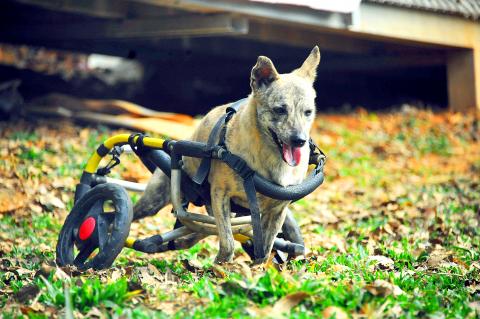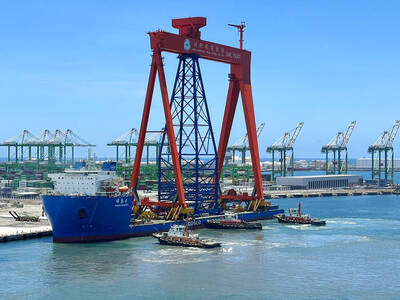Yama was rescued the day he was scheduled to die.
Condemned to death because a car accident left his hind legs paralyzed, the golden retriever was taken to a shelter in Taichung where he eventually regained the ability to walk. He now spends his days lounging in the office of the Taiwan Companion Animal Support Association (台灣同伴動物扶助協會), greeting visitors.

Photo: Han Cheung, Taipei TImes

Not all disabled dogs are so fortunate. The shelter has about 20 canines who have yet to regain full usage of their hind legs, mostly paralyzed in car accidents. While they can behave just like any other dog with the help of customized wheelchairs, the association has only been able to adopt out one disabled dog in the past five years because of the extra time and effort required to care for them.

Shelter director Nick Yen (顏旭柏) says the organization has to combat the common idea that all disabled animals should be euthanized before they can even consider promoting them for adoption.
“I hope people can visit and see how our disabled dogs are doing,” he says. “Some can still live happy, healthy lives. They’re upbeat, energetic and playful.”
DEVOTION AND FATE
Very few shelters or organizations in Taiwan are equipped to deal with disabled dogs, Yen says, due to the resources and labor that they take up. At Yen’s shelter, which has more than 200 dogs, one staff member is in charge of the disabled animals, squeezing out their urine and feces three times a day, checking for incontinence and bed sores and fitting them with wheelchairs.

Yen says the shelter’s emphasis on recovery stems in part from cofounder Lin Wen-hsien’s (林文鮮) job as a physiatrist at Tung’s General Hospital (童綜合醫院): like her human patients, dogs too should have a chance at rehabilitation. Since there were few resources for disabled dogs when the shelter began, Yen says it’s been a learning process even with Lin’s expertise.
“Ever since Lin met her first disabled dog, we’ve been looking into how to satisfy their basic needs so they are as happy as healthy dogs, how to take care of them so that euthanasia is no longer an option,” Yen says.
He says that Taiwan’s no-kill shelter policy, implemented in February last year, doesn’t mean that no animals are put down. The severely overcrowded public shelters, 5,608 dogs as of last month with many cities at overcapacity, can still euthanize animals whom they deem too sick or disabled to avoid taking too many resources from dogs that are more adoptable.
Even Lin’s shelter is at maximum capacity for disabled dogs.
“Any more dogs and it will bring down the quality of life for the ones we have,” Yen says.
Yen expects most of the disabled dogs to stay in the shelter for the rest of their lives. While some dogs require less care than others, depending on the severity of their disability, it still takes the right person to adopt them.
“If someone wants to try, we’ll give them all the support we can,” Yen says. “It takes much devotion and a stroke of fate [to connect the person with the dog].”
WHEELCHAIR EXCHANGE
The quality of life for the shelter’s disabled dogs has been boosted by customized wheelchairs they’ve sourced from a maker in Yilan. Three times a day, they are lifted from their cribs and put into the wheelchairs that allow most of them to run at full speed. They dig holes, scurry around, socialize and fight with each other like they were never injured.
“Even if they can’t run, it’s okay,” Yen says. “At least the wheelchair can get them enough exercise so that their muscles don’t atrophy. Even if they’re just out there getting some sun, it helps just to have them support their body weight.”
Recently, The PACK Sanctuary in New Taipei City’s Sanchih District (三芝) reached out to the shelter under its new directive to collaborate with more animal welfare organizations. PACK has six disabled dogs who have been sitting in a room for years with little rehabilitation. Yen gave them tips on caring for the dogs and donated a wheelchair for them to try.
While some dogs were hesitant, Lucy, who has been disabled for about two years, took to the wheelchair right away and is now the mascot for the shelter during their public events. She’s also shown signs of regaining the use of her legs after acupuncture and physical therapy.
“Everything has changed about her, even her stool,” the PACK CEO Tim Gorski says. “She had diarrhea for two years. I didn’t even change her diet; I just put her in a wheelchair and she got some exercise.”
Even though people fawn over Lucy wherever she goes, Gorski doesn’t expect her to be adopted.
“I think she’s up for adoption to the right person,” he says. “Probably someone who’s retired, who knows about care for animals or people and who have a lot of time and energy.”
PREVENTIVE MEASURES
Lucy’s story is what Yen is trying to prevent — once she got hit by a car, her owner didn’t know how to take care of her and took her to a government shelter. She was rescued the day before her scheduled euthanasia.
“People should treat them as they would a member of their family,” Yen says. “If something happened [to the human member of a family], they wouldn’t just give up on them like that.”
As for preventive measures, Yen encourages dog owners to keep their best friend on a leash.
Gorski says that another problem is people hitting dogs and driving away because they’re not sure what to do. The sooner the dog gets help, the better the chance they have to walk again. Dogs tend to move after they get hit, and even if the driver calls animal rescue, they won’t come out without an exact location.
“If possible, get out there and do the same thing you would for a person,” Gorski says. Throw a blanket on the dog to calm it down, then wrap it up and bring it to a veterinarian, or at least to the side of the road and wait for animal rescue to arrive.
“The best thing to do is to keep a blanket in your car,” Gorski says. “Get them off the road first, then decide what to do from there.”

On the evening of June 1, Control Yuan Secretary-General Lee Chun-yi (李俊俋) apologized and resigned in disgrace. His crime was instructing his driver to use a Control Yuan vehicle to transport his dog to a pet grooming salon. The Control Yuan is the government branch that investigates, audits and impeaches government officials for, among other things, misuse of government funds, so his misuse of a government vehicle was highly inappropriate. If this story were told to anyone living in the golden era of swaggering gangsters, flashy nouveau riche businessmen, and corrupt “black gold” politics of the 1980s and 1990s, they would have laughed.

This is a deeply unsettling period in Taiwan. Uncertainties are everywhere while everyone waits for a small army of other shoes to drop on nearly every front. During challenging times, interesting political changes can happen, yet all three major political parties are beset with scandals, strife and self-inflicted wounds. As the ruling party, the Democratic Progressive Party (DPP) is held accountable for not only the challenges to the party, but also the nation. Taiwan is geopolitically and economically under threat. Domestically, the administration is under siege by the opposition-controlled legislature and growing discontent with what opponents characterize as arrogant, autocratic

When Lisa, 20, laces into her ultra-high heels for her shift at a strip club in Ukraine’s Kharkiv, she knows that aside from dancing, she will have to comfort traumatized soldiers. Since Russia’s 2022 invasion, exhausted troops are the main clientele of the Flash Dancers club in the center of the northeastern city, just 20 kilometers from Russian forces. For some customers, it provides an “escape” from the war, said Valerya Zavatska — a 25-year-old law graduate who runs the club with her mother, an ex-dancer. But many are not there just for the show. They “want to talk about what hurts,” she

It was just before 6am on a sunny November morning and I could hardly contain my excitement as I arrived at the wharf where I would catch the boat to one of Penghu’s most difficult-to-access islands, a trip that had been on my list for nearly a decade. Little did I know, my dream would soon be crushed. Unsure about which boat was heading to Huayu (花嶼), I found someone who appeared to be a local and asked if this was the right place to wait. “Oh, the boat to Huayu’s been canceled today,” she told me. I couldn’t believe my ears. Surely,